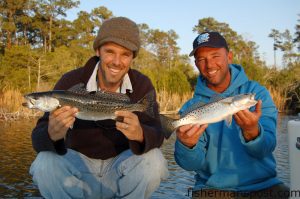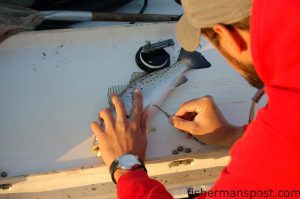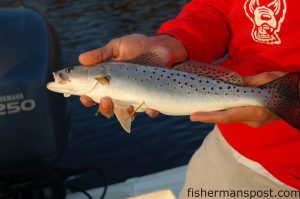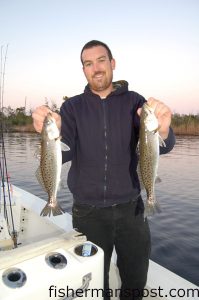The Specialist and The Scientist 2009

Gary Hurley and Capt. Ricky Kellum with a pair of speckled trout just prior to their tagging and healthy release. Both fish fell for pink soft plastic shrimp in a creek off the New River near downtown Jacksonville.
“That’s where we caught them before, Tim. Remember?” Capt. Ricky Kellum said, gesturing towards the timber-strewn shoreline of a creek just off the New River. As Ricky, who runs Speckled Specialist Charters out of Jacksonville, lowered his trolling motor into the water, he glanced back to where Gary Hurley and I stood with Tim Ellis in the 24′ Triton’s cockpit, directing us to select rods from the console holders.
Tim, a Ph.D. student at N.C. State, is conducting an extensive tagging project on speckled trout throughout the state and working with Kellum and a number of other captains to procure fish for his tags. While any reason to go fishing with Ricky is a good one, the opportunity to go out and catch fish while assisting with Ellis’s research was one that we jumped at, and Gary and I made the drive up to Jacksonville on a cold Thursday in late November. We met Ricky and Tim at Jacksonville’s Marina Café as the captain loaded fish into a happy customer’s cooler after returning from his morning charter.
Unlike the trout destined for that angler’s dinner table, all the fish we caught were to be tagged by Tim or Ricky and immediately sent on their way.
After taking off from the marina, Ricky throttled up his Yamaha 250, making quick but chilly work of the run to the creek south of town where we’d be hunting specks for science.
Since the live shrimp which make such good trout baits had already headed for warmer winter climes, this was to be an all-artificial outing, with some inherent friendly competition to see who could bring in the most fish for the tagging. Ricky’s reputation as a master when fishing for specks with artificials had me a bit nervous, and we barely had the rods out of the holders before the wisecracking began.
“I’ll give you guys one cast,” Ricky said grinning, a spinning rod in one hand and the trolling motor tiller in the other. “Then it’s on.”

Tim Ellis, a PhD student at N.C. State conducting a multiyear speckled trout tagging study, uses a curved scalpel to make an tag incision in a trout
Gary and I each fired a pink soft plastic shrimp imitation, perhaps Ricky’s number one “go to” trout bait, toward the shore, while Tim began casting an MR17 MirrOlure in electric chicken, a garish combination of pink and chartreuse near and dear to many trout fishermen’s hearts.
Our “gimme” casts sadly went uninterrupted by hungry specks, and Ricky joined in, casting another pink shrimp ahead of the boat and offering Gary and I some pointers on making the lure work for us.
“You know how a shrimp pops back away from something,” he explained, giving the rod several sharp twitches. “That’s what you want to make it look like. Then stop for a second and let it sink. That’s when they’re gonna hit it.”
Gary and I went back to casting, each trying to emulate Ricky’s shrimp technique as closely as possible. Despite a few noncommittal bumps on the lures, we had yet to hook a fish after 20 minutes, and the captain continued using his trolling motor to guide us along the creek. The spot we were fishing is well known for producing trophy specks. A number of other boats were fishing in the same general area, but no one seemed to be hooking up, at least not in my hurried, mid-cast glances.
Having grown up bass fishing, my instincts told me to cast as close to the woody structure protruding from the creek banks as possible, but after my third hang-up forced us to maneuver to the obstruction and free my lure, Kellum explained that this close quarters trout fishing is a little different than casting for largemouths.

Ellis displays the tagged trout, one of over 400 he’s had a hand in tagging so far, just prior to its release. This yellow-tagged fish will be worth $5 to anyone recapturing it, and there’s a phone number on the tag to call and redeem it.
“They’re not on the banks. They’re out on the edges of the channel and holes,” Ricky explained, repositioning us to cast to prime water. After we worked our way around another bend, Kellum finally popped his rod tip up much more sharply than he had when working the shrimp. His rod stayed bent while the tip bounced from the spastic head shakes of our quarry.
“Head shaker,” he said, working the fish closer to the boat. “That’s a trout.”
Sure enough, moments later the captain slid his landing net under the iridescent flanks of a feisty speck, and he placed the fish in his livewell in order to keep it healthy for tagging while we made more casts near where the bite had occurred.
“There’s one for the pink shrimp,” the Specialist said just before firing another cast toward the flat edge where he’d hooked up.
I’d abandoned the now proven shrimp in favor of an MR17 tied to another of Ricky’s rods, but decided to stay faithful to the MirrOlure, following Ricky’s cast closely with one of my own, and willing a fish to inhale the bone-colored plug.
Just minutes later and casting to the same area, I heard a note of surprised joy come from Gary, and looked up to see his rod tip dancing (and not with one of the tiny flounder he’d hooked early in the trip). The pink shrimp had struck again, and Gary’s fish appeared to have a little more power than the trout Ricky had placed in the livewell.
Soon after he’d set the hook, the trout’s back broke the surface of the creek, revealing Gary was indeed battling a slightly larger fish.
After a few back and forth moments as he worked the fish closer to the boat, Gary was able to lead the speck to the net Ricky had waiting for it, and our second tagging candidate soon hit the deck, the glittering pink imitation it had mistaken for a late lunch protruding from its mouth. After Ricky slid the deceptive meal from the trout’s maw, it joined our first fish in the livewell.
Driven to add my own contribution to Tim’s research and with some fish obviously in the area, I continued casting the MR17, my confidence in the hard bait bolstered by a fish Tim had just hooked and lost on the electric chicken plug. However, none of our next series of casts met with the results we were looking for, and Tim and Ricky decided to take a quick break from fishing to tag and release the pair of specks we’d already boated.

Max Gaspeny with a pair of speckled trout that struck a green curlytail grub while on a trout tagging mission with Capt. Ricky Kellum, of Speckled Specialsit Charters, and Tim Ellis, from N.C. State University.
Tim’s tags for this phase of the project consist of yellow or red internal anchor tags (often referred to as “spaghetti” tags by anglers) implanted low on the fish aft of the pectoral fins. While anglers can easily plant dorsal-side dart tags on hardier fish with a tag stick, the more delicate trout require an up close and clinical procedure.
Laying Ricky’s 15-inch trout on the Triton’s rear casting platform, Tim produced a special scalpel and made an incision in the trout’s belly.
“This scalpel has a rounded blade to prevent us from cutting the fish too deeply and damaging anything internal,” Tim explained as he set the scalpel down and produced a pair of the yellow anchor tags.
Earlier he’d told me that around 25% of the fish would be receiving two tags in order to provide some data about tag loss in wild fish. Although Tim is assessing tag retention in sea trout in laboratory tanks, the wild, free-ranging fish are able to use natural structure like rocks and the fallen timber so prevalent where we were fishing to scrape off the tags, a variable not easily replicated in the lab experiment. Fish that were double-tagged and recaptured with only one tag remaining will give Tim an opportunity to estimate tag loss rates in the wild, vital for developing effective tagging study strategies.
Tim’s current project began in early October, and thus far he’s placed tags in around 400 fish from Oregon Inlet south to the Cape Fear Region, spreading out the research to gather data on trout all over the state. As of our trip and just six weeks into the yearlong project, three have already been returned in the northern part of the state, with two of the three being double-tagged fish and still bearing both tags. One of his trout traveled over 95 miles in just a month, from Oregon Inlet to Slocum Creek off the Neuse River.
Monetary rewards motivate anglers catching one of Tim’s tagged trout to report it, with the yellow tags earning anglers a choice of $5 or a hat or t-shirt, and lucky anglers landing a speck bearing one of Tim’s red tags will receive $100. To redeem their tags, anglers simply snip them off of the fish (enabling them to release the speck if desired) and dial the 1-800 number printed on the tags. For the yellow tags, anglers simply read off the tag number when reporting, along with giving some basic information about the catch. Red tags must be mailed in to researchers in order to claim their more significant reward.
After Ricky took the scalpel over from Tim, planting a single yellow tag into Gary’s larger 18″ fish, we returned to casting.
I soon felt a bump on the MR17 and reared back to the telltale head shakes of another trout. However, this fish had a bit more talent in avoiding the boat. It tossed the hooks while boiling to the surface on its initial surge, giving me a fleeting look at what would have been my first tagger.
Casting for a few more minutes without any more action, Ricky made the call to move up the creek a bit, stowing the trolling motor in favor of the Triton’s outboard. The run took less than five minutes, and we soon were back to casting.
I abandoned the MirrOlure in favor of one of the pink shrimp, and we casted to another section of narrow creek channel lined by fallen trees and other debris. After just a few casts, however, I saw Ricky’s rod again snap backwards, upper half remaining bent by the resistance of another fish, and the manic dance of the tip indicated trout.
Indeed, another trout rose splashily to the surface off the boat’s starboard gunnel, and Ricky quickly boated his second speck of the day, another victim to the pink shrimp. It would soon be released with a flashy tag in its flank.
I had a bite but failed to connect with the fish. A few casts later, another bump on the lure led me to set the hook again, and this time the braided line telegraphed the inanimate resistance of an underwater log, something I was becoming far too familiar with. It seemed that trying to challenge Ricky Kellum at casting artificials for trout may have been a bit ambitious, given my ratio of no fish and at least a half-dozen snags to Ricky’s snag-free two trout numbers.
This time the pink shrimp proved unsalvageable, and I broke it off, looking to Ricky’s bristling rod rack for clues as to what to cast next. For some reason, an old classic trout lure appealed to me, and I turned to the bow to ask the captain’s opinion.
“You think it’s worth throwing this green grub?” I queried, holding up a 4″ soft plastic glistening with metal flakes threaded on a light jighead.
“Oh yeah, I had a man catching them on the grub this morning,” Ricky replied. “You don’t even have to do anything. Just cast it and reel it in.”
“Perfect,” I replied sending a cast towards the creek’s far bank. “It feels like a beginner bait is exactly what I need.”
A few casts later, Ricky decided another short move up the creek was in order, firing up the outboard again to take us a quarter mile or so further up the winding waterway.
This time I was first to the action, as something pounced on the grub while it sank on my third cast. I even successfully pulled off the hookset, and soon Ricky was dipping a 16″ class trout up in the net. The beginner bait had been exactly what I needed.
Pleased with the fish in the livewell, I returned to casting, humbled again quickly by a near immediate strike that went unanswered (an unsuccessful hookset).
The green grub, however, seemed to be the ticket at our new spot, and I redeemed myself by hooking up again after a few more casts. Once more I succeeded at keeping my adversary hooked until the 15″ trout reached Ricky’s waiting net.
With two more trout in the boat and light beginning to fade under the constraints of Daylight Savings Time (which seems to take me longer to get used to each year), Tim and Ricky set about tagging my two fish, both recipients of single yellow tags.
After sending the two specks on their way with some fashionable new accessories for the winter season, we continued our casting.
The phase of Tim’s tagging project we were participating in is only the preliminary one in what will be a long endeavor to develop a successful long term tagging project for the coastal waters throughout North Carolina.
The $100 rewards, $5 rewards, and single/double tag studies will help Tim estimate trout mortality associated with hook and line capture, tag reporting rates for both high and low reward tags in the commercial and recreational angling sectors, and the tag loss rate for the fish in the wild. Another phase of the project he’s developing includes working with a veterinarian to create a successful procedure for implanting the fish with acoustic telemetry tags and holding the fish in tanks over a long period of time to observe wound healing and mortality associated with the telemetry tags.
Together, the varied facets of Tim’s research will enable him to develop an effective, multi-year tagging program that will identify and address problems with low return rates of previous trout tagging studies. Ultimately, the program will foster a better understanding of the North Carolina speckled trout population’s movements, stock health, and natural and fishery-related mortality, which will guide regulators in framing effective and fair guidelines for anglers.
As the light waned and the already brisk temperature began to fall, Ricky made the call to head back for the ramp, and we stowed our rods, satisfied that we’d been able to contribute at least some small part to Tim’s research.
Speckled trout have been identified as NC’s most important sportfish, with anglers expending more effort and dollars (an estimated $29 million in 2006) pursuing them than any other species. Thus, a well rounded understanding of the state’s trout population and the impact of recreational and commercial fisheries is vital to not only the health of the species itself, but also to North Carolina’s substantial number of coastal recreational anglers, a hefty source of revenue for coastal communities from the Virginia border to the southernmost reaches of Brunswick County.
The opportunity to participate in Tim’s research while also enjoying a trip with the Speckled Specialist (who has put over 3,000 trout in the boat with clients this year) made this day doubly satisfying, and Gary and I returned to the marina with wide smiles on our faces in spite of the polar wind created when the Triton is skimming along at 50+ mph (Thanks for the jacket, Ricky!).
For more information on charters with the Speckled Specialist, give Capt. Ricky Kellum a call at (910) 330-2745 or visit his website at www.speckledspecialist.com. For more information on NCSU’s speckled trout tagging research, contact Tim Ellis at (800) 790-2780 or at taellis@ncsu.edu.





